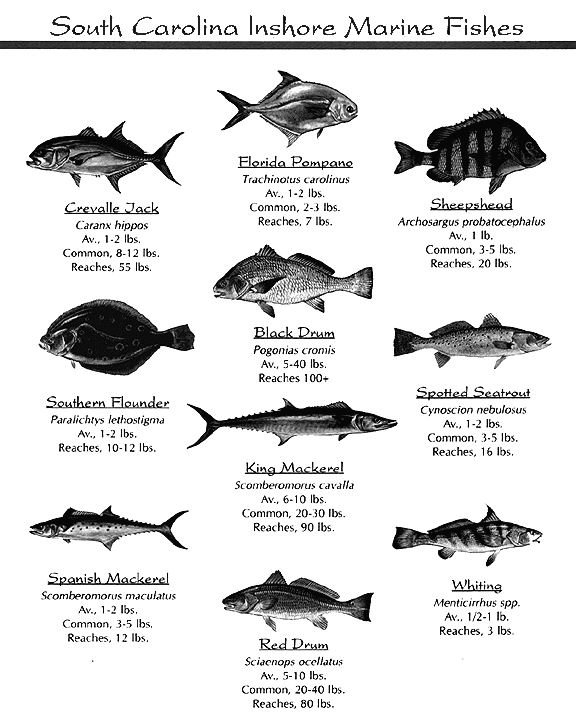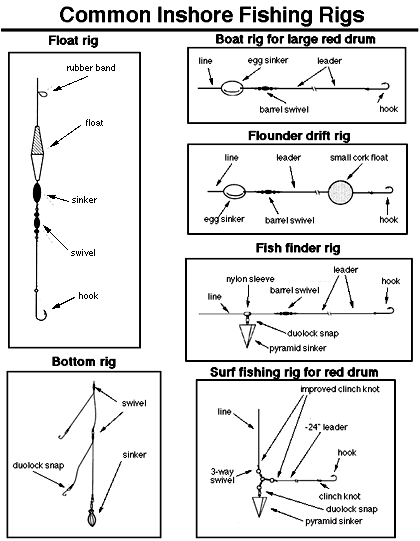

With the heat of the summer, inshore fishing slows somewhat compared to spring and fall. However, in summer many different fishes are available to inshore anglers. Among these are: spotted seatrout, red drum, black drum, flounders, whiting, Spanish and king mackerel, sheepshead, and crevalle jack. As a general rule, summer fishing is better at dusk and dawn. During this time of the year estuaries and coastal waters are filled with a variety of bait fishes and shrimps preyed upon by game fish. As a result, live baits will catch more fish than artificial lures at this time.

During the summer, spotted seatrout occur in lower parts of estuaries and prefer live baits. In early summer you can get brown shrimp for bait with a cast net at low tide in many areas. Later in the summer, white shrimp will be large enough to use for bait. Also, small menhaden and finger mullet can be obtained with a cast net and you can catch mud minnows either with a baited minnow trap or with a cast net in shallow creeks.
As in the spring and fall, the best fishing is around areas with structures, such as oyster bars, rocks and pilings during periods when the tidal currents are running. The baits may be fished either on the bottom with a slip sinker above a 20-pound test monofilament leader attached to a 1/0 or 2/0 hook or from a float rig. Generally in the summer, trout fishing is quite spotty as the fish do not form large schools typical of cooler periods of the year.
Summer fishing for red drum is slower than during the spring and fall. During July, small juvenile red drum, 8 to 10 inches in length, leave the shallow creeks and form schools in the main estuaries. At this time they are very easy to catch, but are smaller than the allowable minimum size in South Carolina of 15 inches and should be released. These fish will attain legal size in the fall.
During late summer, anglers are frequently successful in catching larger fish (up to 20 to 30 pounds) around jetties and at the mouths of bays and sounds. Baits used are either live menhaden, finger mullet or fresh cut mullet. These baits are presented on fish-finder rigs on the bottom. A 50-pound test monofilament leader attached to a 6/0 hook is satisfactory for cut bait. For live bait, use a slightly smaller hook (4/0) so that the bait can swim more naturally in the current. Cut baits are fished on the bottom, whereas live baits may be fished either on the bottom or floated along the jetty rocks.
Flounders are quite abundant in the estuaries during the summer months. This is the time of the year when some folks drift along the shallows during calm nights on an early incoming tide to gig flounders. The boats are generally shallow draft such as jon boats and have lights set up on the bow to illuminate the bottom directly ahead of the boat. As one person poles the boat, the other stands in the bow with a four-pronged spear and strikes any flounders he can see on the bottom. When the night is calm, the water clear and the fish available, quite a few flounders can be harvested.
Many Grand Strand fishermen troll for flounders during summer around inlets. Live baits, such as mud minnows are trolled slowly along the bottom or adjacent to jetty rocks. Other areas where flounders can be caught are inlets north of Charleston, such as Dewees Inlet, Capers Inlet and Prices Inlet.
During the summer, sheepshead can be caught around jetties, pilings and bridge piers. Fiddler crabs and live shrimp are the best baits and they can be fished either with float rigs (which are successful around the jetties) or with 1/4- or 3/8-ounce split shot weights crimped to the leader. The hook sizes used are no. 1, 1/0, or 2/0 and the leader should be about 20-pound test monofilament. Frequently you have to move from place to place along the rocks to find fish.
Black drum are bottom feeding cousins of the red drum. They feed oncrabs, shrimp, clams and mussels and do not consume fish. They occur around rocks, pilings and bridge piers. Since they are mainly bottom feeders, a fish finder rig works well. When fishing for black drum you may hook a fish that weighs 5 pounds or you might grab onto one that weighs as much as 40 pounds.
The best bait for black drum is a large piece of blue crab. To prepare the bait, pull the top shell from the crab and cut it into quarters. Thread a large piece of crab onto a 5/0 to 9/0 hook tied onto a swivel with 50-pound test monofilament. Above the leader, which should be from 18 inches to 2 feet long, a 2 to 3-ounce slip sinker is used to get the bait to the bottom. Smaller black drum are delicious, but the larger fish (over 15 pounds) have a coarse flesh. If you catch a large fish you do not plan to eat, it should be tagged and released.
During late summer, the fine tasting pompano is relatively abundant in the surf zone but not heavily fished. Pompano frequent the surf zone right where the waves break in "suds" on the beach. These fish feed on mole crabs which live in this high energy area. The crabs burrow into the sand as the wave breaks, and as the water retreats from shore after breaking, the crabs strain the water for microscopic food items that are suspended by wave action. Before the next wave breaks, these small crabs (1/4 to 3/4- inch in length) burrow into the sand.
Not all mole crabs manage to bury themselves after each wave, however, and some are swept short distances from the beach by the retreating water. Pompano cruise just beyond the foam feeding on these crabs.
Pompano have small mouths and since mole crabs also are small, a no. 1 or no. 2 hook should be tied directly onto the line (8- pound test) from the reel. Flip the baited hook into this area and allow it to be carried about by the current. A very small piece of split shot (1/16 or 1/32 ounce) on your line will keep it slightly down in the water column as it drifts. A small float about 12 or 16 inches away from the hook gives a better idea of the location of the bait.
Pompano in the surf generally weigh less than a pound but are fine food fish. If the bait is too far offshore you will not catch pompano. If you fish directly in the suds, you might still miss them but you may latch onto a whiting, a small red drum, or even a flounder. Like pompano, these other fishes are letting the wave action bring them a nice mole crab dinner.
During the summer, whiting can be caught in the surf around the groins and in the sloughs and cuts along open beaches. Whiting feed on small worms, crabs, and shrimp. They generally weigh less than a pound and have a relatively small mouth. A rig with two leaders with no.1 or 1/0 hooks baited with cut shrimp fished on the incoming tide frequently will catch whiting during the summer. Although they are not large and do not fight as hard as many of the other inshore fishes, they certainly make up for these shortcomings by being excellent table fare.
During the summer months, the numbers of both of these fishes decrease in comparison with the spring. There are a few kings and Spanish around ship channels and on occassion you can locate a school of Spanish a few miles off the beach by looking for seabirds diving on the baits scared to the surface by the fish. Best times are at dawn and dusk which seems to be the period when these predators are most active.
During summer, kings are caught with live menhaden trolled slowly or drifted under a large float. The same general techniques that worked in the spring are used to catch kings in the summer.
When inshore waters warm in the summer, a southern visitor enters our estuaries to terrorize small menhaden and other small baitfishes. These are the 'jacks.' They do not make spectacular long runs like large king mackerel and they do not perform graceful jumps like tarpon, but they are one of the toughest fishes encountered in inshore waters.
At night or at dusk and dawn during the summer months, jacks lurk around rips during ebb tide feeding on mullets, menhaden and silversides. Experienced anglers use 20-pound test line on a large capacity reel and a moderately stout rod. Good baits for jacks are surface popping plugs like the Striper Swiper or swimming plugs like the Redfin, Rebel, or Rapala.
During the daytime you frequently can spot a school of jacks milling on the surface. This type of fishing requires two people; one casts from the bow of the boat while the other runs the boat to intercept the school of fish. Large yellow bucktails or Hopkins spoons work well during the day. During the daylight a hooked jack will attempt to run back to the school and once it gets into the school, the line will be cut by the other members of the school. Jacks are not good food fish and should be tagged and released.

Although most people once considered ocean resources to be unlimited, recent repaid declines in the populations of many commercial and recreational species have demonstrated the opposite.
Numerous types of saltwater game fish now are being overharvested and other species will face a similar fate unless all anglers practice wise conservation and adopt an ethical approach to fishing.
Size and catch limits, seasons and gear restrictions should be adhered to strictly. These regulations change from time to time as managers learn more about fish life histories and how to provide angling opportunities without depleting stocks.
The challenge of catching, not killing, fish provides anglers with the excitement and the reward of fishing. Undersized fish, or fish over the limit should be released to ensure the future of fish populations. The number of saltwater fish tagged and released increases annually in South Carolina as more and more fishermen take up this practice that provides information on growth and movement of fish as well as conserving resources.
The positive impact of tag and release has been demonstrated dramatically by the Governor's Cup Billfishing Series. Begun in 1989, this annual event, encompassing the major spring billfishing tournaments, has resulted in a new conservation emphasis among offshore anglers. Now, more than 85 percent of billfish brought to the boat are tagged and released by both tournament and non-tournament anglers. Catches of blue marlin, white marlin and sailfish have increased each year as a result. Saltwater fishermen can further contribute to conservation by purchasing a Marine Recreational Fisheries Stamp which is required to fish from a private boat or to gather shellfish in South Carolina's saltwaters. Funds generated by the sale of stamps must be spent on programs that directly benefit saltwater fish and fishermen.
Help ensure the outdoor enjoyment of future generations by strictly adhering to all rules, regulations, seasons, catch limits and size limits, and through the catch and release of saltwater game fish.
This publication was made possible with funds from the sale of the South Carolina Marine Recreational Fisheries Stamp. Help ensure outdoor enjoyment for future generations by strictly adhering to all rules, regulations, seasons, catch limits and size limits. The South Carolina Department of Natural Resources publishes an annual Rules and Regulations booklet that lists all saltwater fishing regulations. Have an enjoyable fishing trip by reading these requirements before you fish.
Author: Dr. Charles A. Wenner,
Marine Resources Research Institute
Illustrations: Ron Chapiesky
Fish Illustrations: Dwayne Raver
Series Assistant: Roxanne Baker